Hairless cats are a unique type of feline that has become increasingly popular. Their distinctive lack of fur gives them an exotic, alien-like appearance that many find adorable.

Hairless cat breeds make affectionate and entertaining companions.
However, they do require some specialized care compared to other cat breeds.
Understanding Hairless Cats
Hairless cats lack fur due to genetic mutations that prevent or reduce hair growth. However, they are not completely bald. Most have a fine velvety down covering their body.
Some may have sparse fur in specific areas like the tail, face, or feet. The skin of hairless cats requires diligent care and protection.
Choosing a hairless cat:
There are over half a dozen recognized hairless breeds to choose from. Consider your lifestyle and the cat’s personality.
Bambinos and Minskins are great small apartment cats, while the vocal Peterbald needs lots of attention. Proper breeding ensures health. Kittens from parents with skin conditions should be avoided.
Keeping them warm:
Hairless cats feel cold quickly and struggle to keep warm. Make sure your home is consistently warm.
Dress your cat in shirts, sweaters, or pajamas when needed. Heated cat beds and microwavable heating pads provide cozy spots to curl up. Hairless cats appreciate blankets and will burrow themselves in.
Protecting their skin:
Hairless cat breeds have exposed skin that needs vigilant care. Bathe them weekly to remove oil buildup. Apply pet-safe sunscreen before outdoor time.
Check their skin for cuts, irritation, or infection and treat any issues promptly. Keeping their skin clean and healthy prevents problems.
Grooming tips:
In addition to regular baths, groom hairless cats by gently wiping their skin folds with pet wipes to remove dirt.
Pay attention to face wrinkles. Clean their ears weekly with cotton balls to prevent infection. Clip nails carefully to avoid scratches. Brush their teeth frequently to reduce dental disease risk.
Sphynx
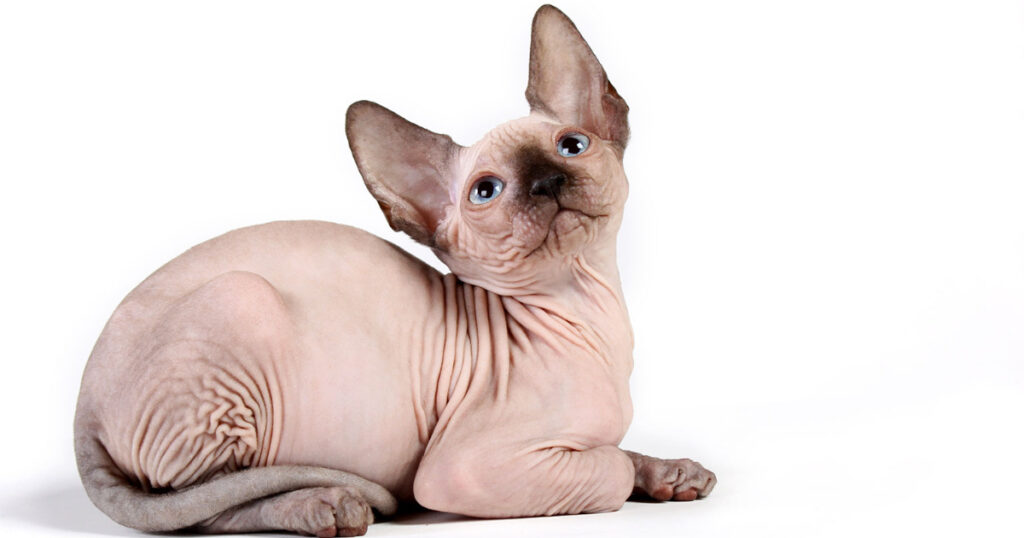
The Sphynx is the original and most well-known hairless breed. They first came about in 1966 when a hairless kitten named Prune was born to a domestic shorthair cat in Toronto, Canada. Breeders began intentionally breeding hairless cats from Prune’s line, establishing the Sphynx breed.
Despite their name, Sphynx cats are not completely bald. They have a fine down covering their body that can be hard to see. Some may also have sparse hair on the tail, nose, and ears. Sphynx cats have slender, muscular body with distinctive wrinkled skin and large ears. Their skin comes in a variety of colors and patterns.
Known for being extroverts, Sphynx cats are incredibly friendly, energetic and demand human attention. They get along well with other pets and love cuddling up with their owners.
Bambino

The Bambino is a dwarf breed that resulted from crossing a Sphynx with a Munchkin cat. They have the hairless coat of the Sphynx along with the short legs of the Munchkin. Most Bambinos weigh 5-9 lbs.
These tiny cats are bursting with affection and personality. Despite their small size, they are lively and love playing with their owners. Bambinos crave attention and don’t like to be left alone for long periods.
Donskoy

Originating from Russia in the 1980s, the Donskoy is an intelligent, playful, and wrinkly breed. They are also referred to as the Russian Hairless or Don Sphynx. However, unlike the Sphynx, their hairlessness comes from a dominant gene.
An interesting trait of the Donskoy is that some cats will grow a winter coat when it gets cold, which they shed in spring. Donskoys are affectionate and get along well with humans and other pets.
Peterbald
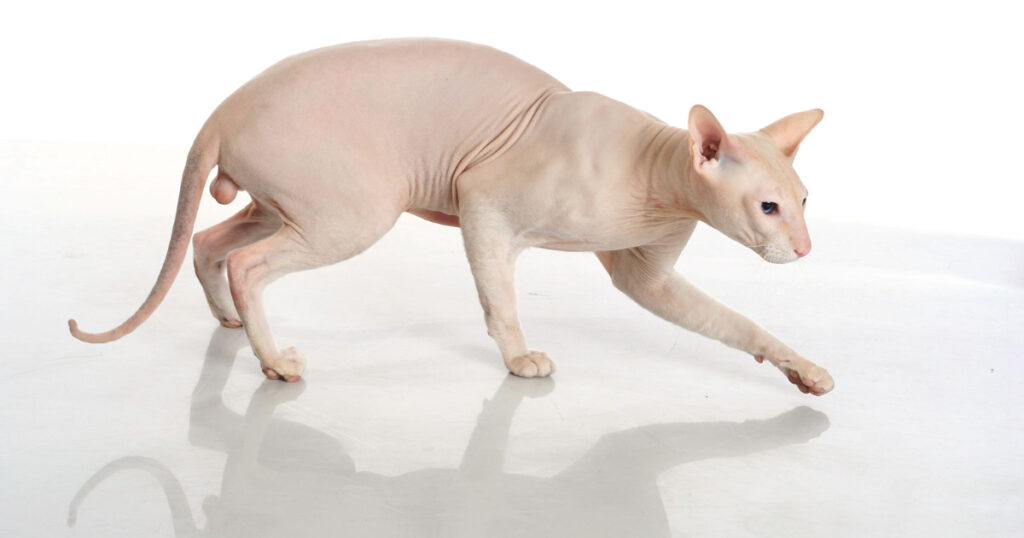
This elegant Russian breed was developed in 1994 by crossing a Donskoy with an Oriental Shorthair. Peterbalds can be born completely hairless or with varying levels of fur, from peach fuzz to a normal coat.
Peterbalds have a lively, affectionate personality. They are very vocal cats that love “talking” to their owners. With their tall ears and slender figures, these cats have a unique oriental look.
Minskin

The Minskin breed originated in Boston during the late 1990s and early 2000s. They resulted from crossing the Sphynx, Munchkin, Burmese, and Devon Rex breeds.
These tiny, hairless cats have long torso and very short legs. They typically weigh just 4-6 lbs. Minskins are intelligent, energetic and love interacting with their human families.
Dwelf
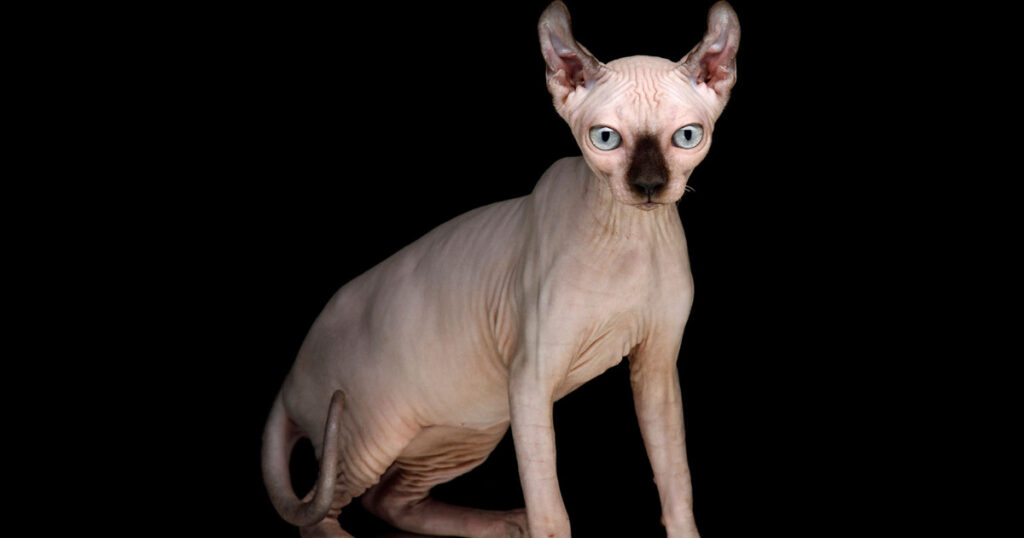
With its hairless coat, short legs, and curled ears, the Dwelf has a truly unique appearance. This breed originated from breeding Sphynx, Munchkin, and American Curl cats together.
Dwelf cats rarely exceed 5 lbs in weight. They have loads of energy and are known for being highly playful. Many Dwelf owners say these cats act more like dogs than cats.
Lykoi
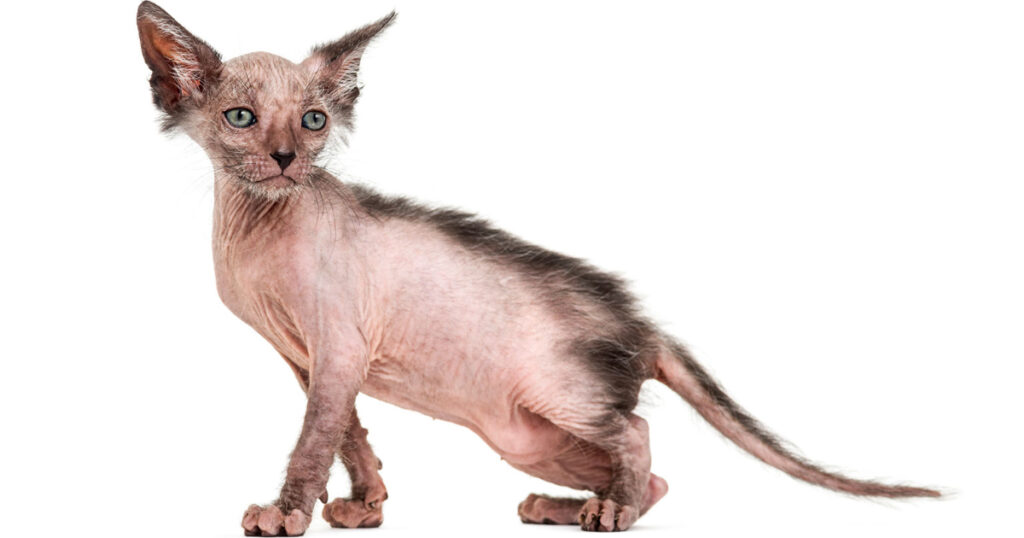
While not all Lykoi cats are hairless, this breed is included due to its partial hairlessness. Lykoi cats periodically shed hair around their face, ears, legs, and feet. This gives them a werewolf-like look.
When not shedding, Lykoi cats have short black/grey coats. They are energetic, playful and get along well with humans and other pets.
Elf
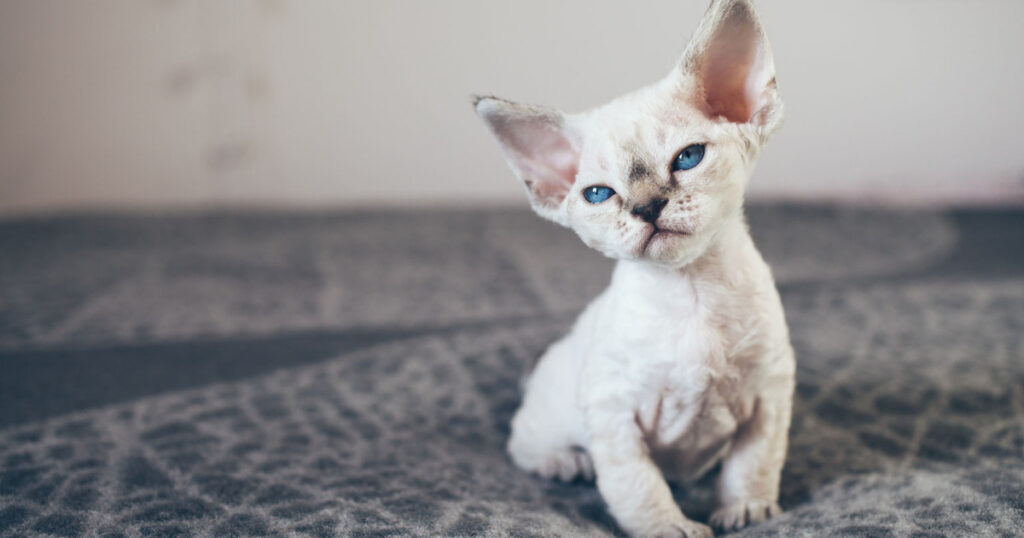
With their curled ears and wrinkled skin, Elf cats live up to their mystical name. This breed originated from crossing the Sphynx and American Curl.
Elf cats love climbing and will find plenty of high places to perch in your home. They are gentle, playful, and very attached to their owners. Providing them with a cat tree or scratching post is a must.
Ukrainian Levkoy
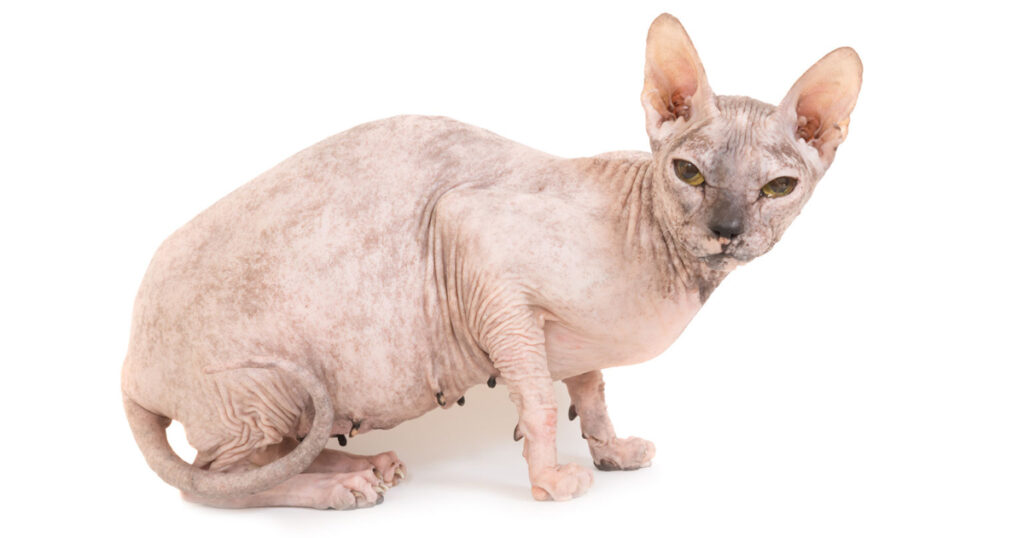
Ukrainian Levkoy cats have inward-folding ears and wrinkly, elastic skin. They resulted from breeding Donskoy and Scottish Fold cats in the early 2000s.
These hairless cats are laid-back but love playing and interacting with their families. Some Ukrainian Levkoys have fine fuzzy coats, while others are completely bald.
FAQ
Are hairless cats hypoallergenic?
No, there are no truly hypoallergenic cats. Allergies are triggered by cat saliva, urine, and dander proteins rather than their fur.
However, some people may react less severely to hairless breeds as they have less dander and shedding.
How do you care for a hairless cat?
Hairless cats require weekly bathing to remove oil buildup on their skin. Their skin needs protection from the sun and cold. Many owners dress their cats in shirts and sweaters.
Hairless cats should be indoor pets and require a warm, consistent environment.
What health problems do hairless cats have?
Lacking fur, hairless cats are prone to skin problems if not cared for properly.
They are also at higher risk of dental issues. Responsible breeding has made most hairless breeds quite healthy, but care must be taken to prevent skin infections, dental disease and maintain an ideal weight.
Conclusion
Hairless cats may look very different from the average feline, but they make for equally loving and entertaining pets.
From the popular Sphynx to the unusual Dwelf, hairless breeds are great for those wanting an affectionate, cuddly cat.
Just be prepared to put in extra effort caring for their special grooming needs. These wrinkly, fur-free kitties can be cherished companions when looked after properly.








